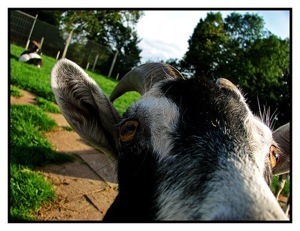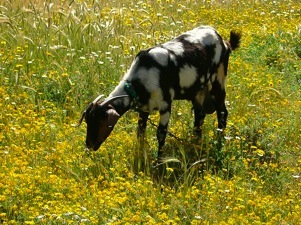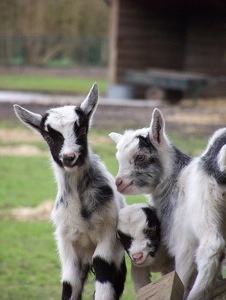Adaptations

“A goat? What’s so Special about A Goat?”
Goats have many adaptations that allow them to
live and prosper in their grazing lifestyle. For
example, Capra hircus has a four-chambered
stomach that gives it multiple advantages. First,
this stomach contains bacteria that breaks down
cellulose in the grasses and leaves that the goat
consumes. This allows the goat to gain energy
from plants that many other animals cannot.
In addition, the first chamber of the stomach, the rumen, has an extremely large capacity of 10 ½ quarts. This allows the goat to consume very large amounts of food in a small amount of time, without taking time to chew it. Later, the goat will regurgitate a small portion of it and chew it again. While this process is not the most pleasant to think about, it permits the goat to minimize the time that it is grazing in the field with its attention diverted from its surroundings. While eating, goats are extremely vulnerable to predation. This process allows them to decrease that vulnerable period and later re-chew when they are safe from harm.
The extent of the goats digestive system also allows them to utilize food sources that even other ruminates (animals with a rumen) cannot. Goats have been known to eat anything from plants, to tree bark, to garbage, to tin cans, and due to their digestive system they can. While some sources, such as the tin cans, supply them with little to no energy, others provide a means for them to live. Because of Capra hircus’s wide range of food sources, the species can exploit areas of very sparse vegetation.
For more information about goat digestion and the four-chambered stomach, see Nutrition.
Another adaptation of the goat is found in its
pupil. While some organisms have circular or
vertically slit pupils, Capra hircus has horizontal
slits. This orientation allows goats to have greater
peripheral vision. This peripheral vision is
especially important for goats because its helps
them to have a greater sense of awareness of
their surroundings and detect predators more
easily.
For more information about predation,
see Interactions with Other Species.
Last, goats show adaptation in their reproductive cycle. A
female Capra hircus begins its estrus cycle in the fall and
winter using signals of decreasing sunlight as a starting cue.
As the gestation cycle of a goat lasts around 150 days,
this practice ensures that young will be born in the spring
and summer. Spring and summer breeding would lead to
late fall and winter births. Young goats born in winter have
a very low survival rate.
For more information about goat reproduction,
see Life History and Reproduction.
To return home, click here.
To learn about goat nutrition, click here.
A close up shows the horizontally slit pupils of the goat.
Photo by David Reece
A goat grazing in the field.
Photo by palestrina55
Baby goats play a few days after their birth.
Photo by ynskjen



